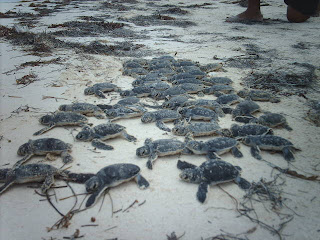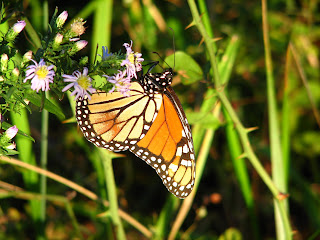1. Katydid

After spending 17 years in the soil, shrill insect, katydid will migrate towards the outside world to gather together, sing, and mating. Their appearance in a sync, effectively distancing katydid from predators during the five-weeks adult life. Katydid migration distances range from several inches to thousands of kilometers.
2. Lemmings

Rodents like hamsters and mice will do the migration at high speed from his native habitat, the North Pole. Some scientists say the cause of this massive migration occurs because of lemming population exploded without being accompanied by an adequate food supply. Lemmings can move as far as 16 kilometers in one day.
3. Wildebeests

These herbivorous animals will do anything to find a greener pasture. Serengeti wildebeest and zebras and deer can roam hundreds of kilometers in a group to avoid the dry season in Tanzania and Kenya.
4. Green Turtles

Maternal instincts of a green turtle forced him back to the place of birth to start a life with his family. Green turtles which are pregnant can swim thousands of miles from breeding places in Brazil to the South Atlantic ocean to the island of Ascension.
5. Salmon
5. Salmon

Having spent many years in the ocean, salmon will return to his birthplace in freshwater rivers to breed and die. To achieve the objectives, they are willing to swim against the tide, rushing hundreds of kilometer.
6. Rubi Necked Hummingbird

Before flying as far as 804 miles to Central America, the bird will perch ruby-necked Hummingbird in flowers, eating insects, and suck the sap of trees. Rubi Necked Hummingbird will consume two grams of fat, nearly twice the weight of his body to make the trip nonstop from North America across the Gulf of Mexico.
7. Monarch Butterflies

Migration distance is characteristic of the Monarch butterfly. Each spring, thousands of butterfly is flying wide west toward California and Mexico. In the summer, monarch butterflies flying far as 4828 kilometers through the U.S. and Canada. Until now, the cohesiveness of the monarch butterflies migrate is still a mystery to the scientists.
8. Stork whooping

Those Long-legged birds are in danger of extinction. Scientists perform a variety of ways to save these species, including flying lessons taught. By using a machine resembling ultra light crane with remote control, whooping crane led to the protected areas in the south.
9. Freshwater Eel

Eels this one is ready to face the hard birth of life on the water. After hatching in the Sargasso Sea, these eels swam to a number of fresh water river in England and on the east coast of North America. On the way, the kidneys they will adapt to the salinity level of water. When it was time for laying eggs, freshwater eel kidney will return to its original state.
10. Back Humpback Whale

Humpback Whale or humpback whales retain the record for the animals that roam the farthest distance in the world. Some herd the whales weighing 36,000 pounds to spend his time eating tons of food in the arctic peninsula. In winter, they will swim as far as 8046 miles to breeding places near Colombia and in the equator region.